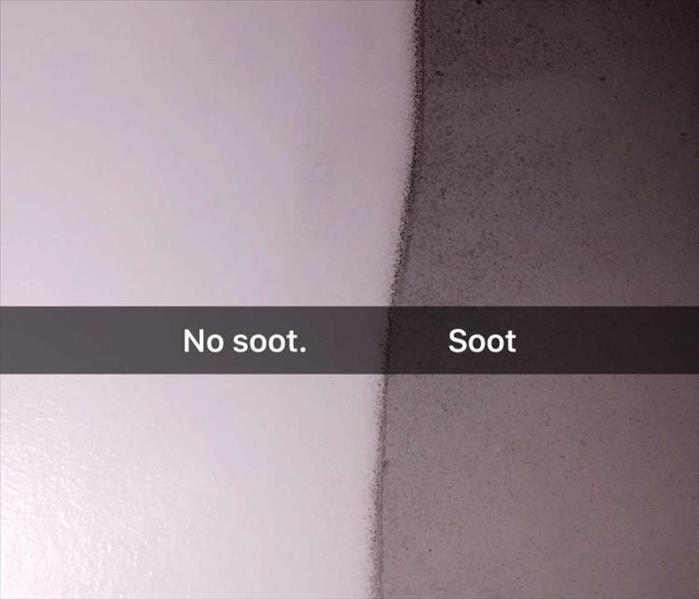Can Smoke Residues Affect Indoor Air Quality?
10/30/2020 (Permalink)
 Fire damage and soot clean up and restoration needed? Stop, think, and then call SERVPRO to restore your Claymont home, "Like it never even happened."
Fire damage and soot clean up and restoration needed? Stop, think, and then call SERVPRO to restore your Claymont home, "Like it never even happened."
SERVPRO Fire Damage Professionals Can Restore the Air-Quality of your Claymont Home After a Fire.
How do fires affect indoor air quality?
A property fire can influence the interior of your Claymont home in numerous ways. Combusting materials release hundreds of chemicals and volatile particles. These can often linger after a fire causing unpleasant odors or affecting indoor air quality. When entering a property with visible signs of smoke or soot soiling, it is vital to wear a respirator to avoid inhaling microscopic dust or soot particles. SERVPRO recommends using an N95 or equivalent respirator when inside the property to filter out potentially harmful micro-soots. Our team can scope your property for potential instances of soot or smoke, which could be airborne and damaging your indoor air quality.
What is the best method for restoring air-quality?
When carrying out fire damage restoration in your Claymont home, it is vital to remember that the most straightforward solutions are often the most effective. Airborne soot and ashes come from smoke residues or soiling that may reside on surfaces. By enacting a cleaning strategy to disconnect these soots from surfaces and then remove them, we can start returning indoor air to a normal condition. Not all soot is the same, which means our crew chiefs conduct a thorough inspection of your home to identify the different types of damage as well as the correct method of eliminating them. Sometimes, we may apply small cleaning solutions or solvents to understand how likely items are to clean without causing excessive harm. A thorough inspection allows us to divide our workload, focusing on salvageable materials and therefore increasing efficiency.
What do production technicians do in a fire-damaged environment?
- Find and identify the types of residue and the surfaces that are affected. Both of these factors can influence the cleaning strategy.
- Technicians seek to capture these residues in a dry particulate form or suspended in a solution.
- Rinse and remove residues and then dispose of them correctly under federal and state laws or regulations.
How do restoration services find and identify residues?
In most situations where some or all of a property requires restoration, SERVPRO sends a project manager and a crew chief. Your insurance adjuster may sometimes accompany these members of staff. Crew chiefs find residues using their extensive training to locate hidden spots, causing odor or stuffy conditions in the property. A production technician usually tests these areas of soiling to assess the cleanability. All of this information relays to you and your insurance adjuster. We can then set to work, separating non-salvageable materials and concentrating on restoring the salvageable materials. Working methodically can help us assign specific tasks and provide an accurate time frame for your restoration procedure.
How are soot and smoke residues removed from surfaces?
- To remove a residue effectively, they first have to be captured, which can refer to suspending or disconnecting the soots from the surfaces they adhere to.
- Professional technicians use air or fluids to dislodge or release soot and smoke particles before carrying them away for disposal.
- Two methods of dealing with bonded soot could be through vacuuming and dissolving the soot soils.
Is vacuuming appropriate for cleaning soots?
It is prevalent for homeowners to seek to aid the restoration. These home disasters can be both inconvenient and traumatic, so it is only natural that a homeowner wishes to help. Vacuuming can be a useful method of collecting carbon residues which may have spread across the home. Carbon particles typically do not bond with surfaces on a chemical level, which means they can often be dislodged or eliminated by agitating the affected surfaces or applying negative air pressure and vacuuming. While these soots may appear relatively benign, they can absorb into surfaces in moisture, making them more challenging to clean. SERVPRO recommends avoiding introducing water to any areas of smoke or soot soiling without first consulting a professional. Sometimes adding a water-based cleaning product like detergent can exacerbate losses.
How are fire soils dissolved?
- Soot that bond to surfaces on the chemical level must be dissolved or suspended in a solvent before they become removable.
- Using a cleaning product can help loosen soots from surfaces, allowing us to flush them away using a cleaning agent.
- Hot water extraction equipment can help remove soots from textiles and other soft furnishings in the home after the application of dry solvents.
Can soot residues be thrown in the trash?
Several rules and regulations are surrounding the disposal of fire soiling and the chemical solvents used to dissolve them. Different states have different rules and laws that we must adhere to and prevent environmental damage. General rules of thumb are to avoid disposing of solvents in septic systems or open-sewer points. Dry cleaning solvents, in particular, must be bagged up in sealed packaging and taken to an industrial waste facility for disposal. Equally, disposing of cleaning fluids in a storm drain is prohibited. SERVPRO can collect debris and waste to take away from your property after restoration is done and leave your home in a clean, preloss condition.
The correct elimination and disposal of soot, ashes, and residues in general from a fire-damaged property are essential to controlling indoor air quality, odor, and loss mitigation. Contact SERVPRO of Brandywine / Wilmington at (302) 762-8080.






 24/7 Emergency Service
24/7 Emergency Service